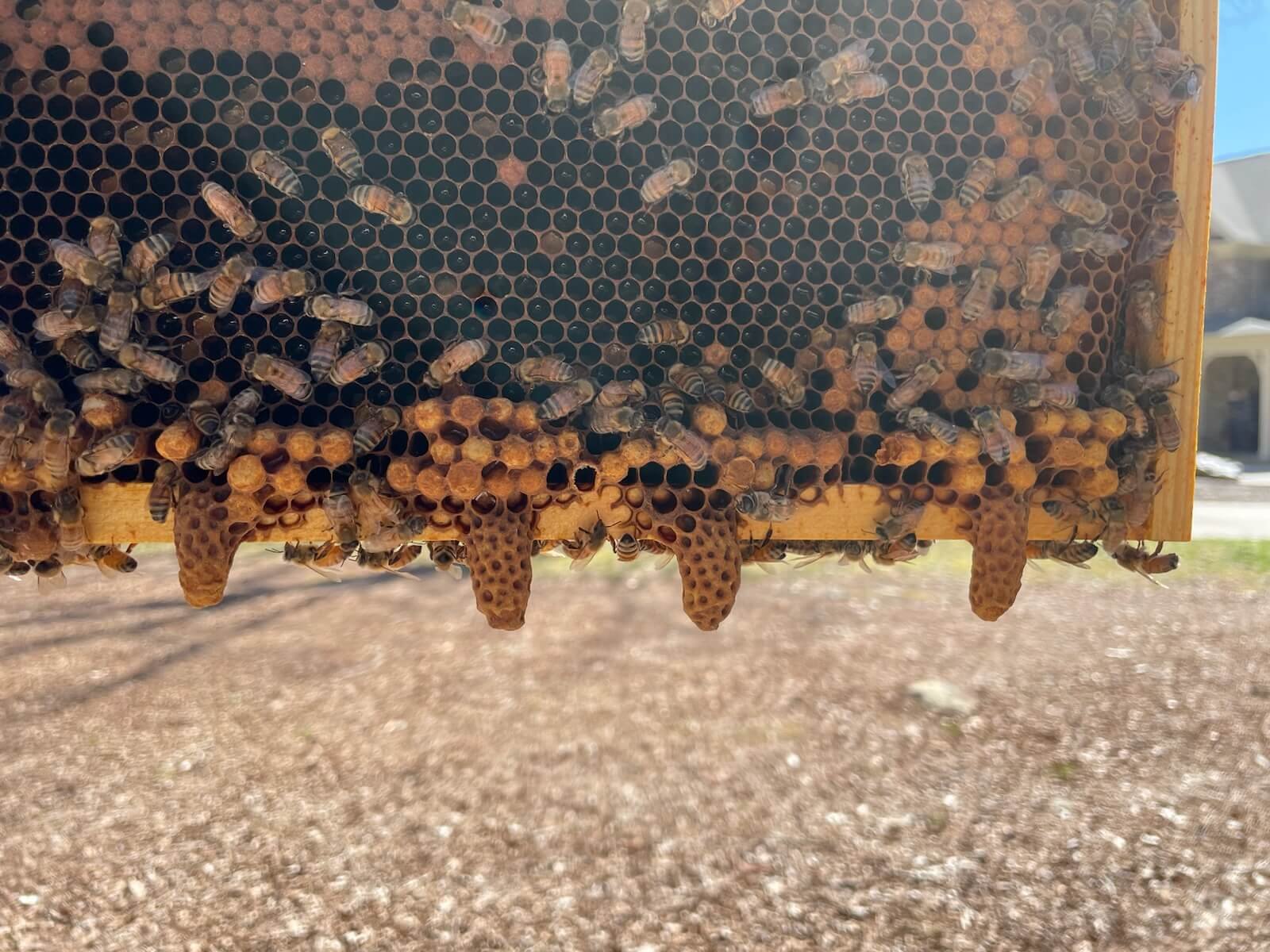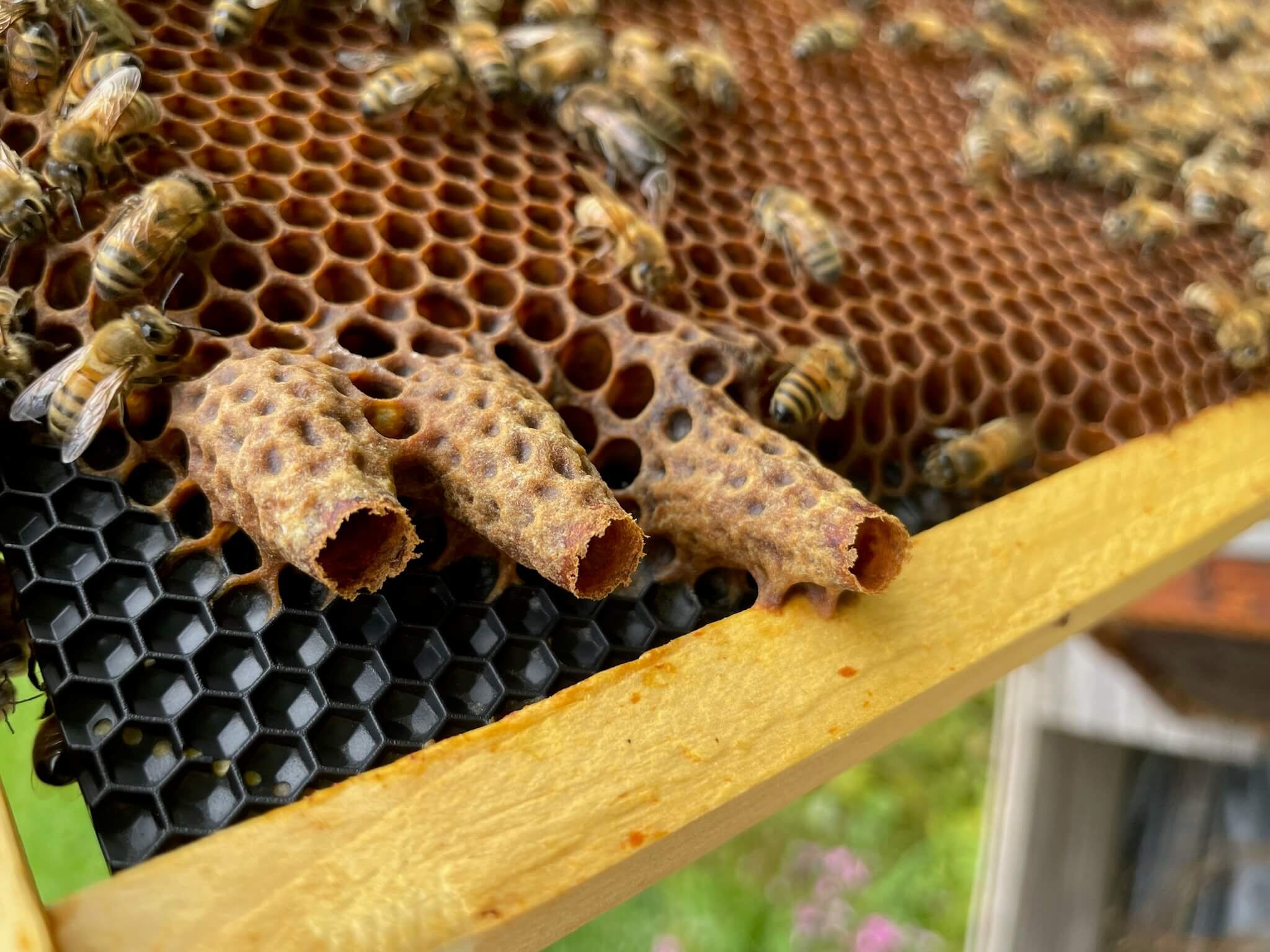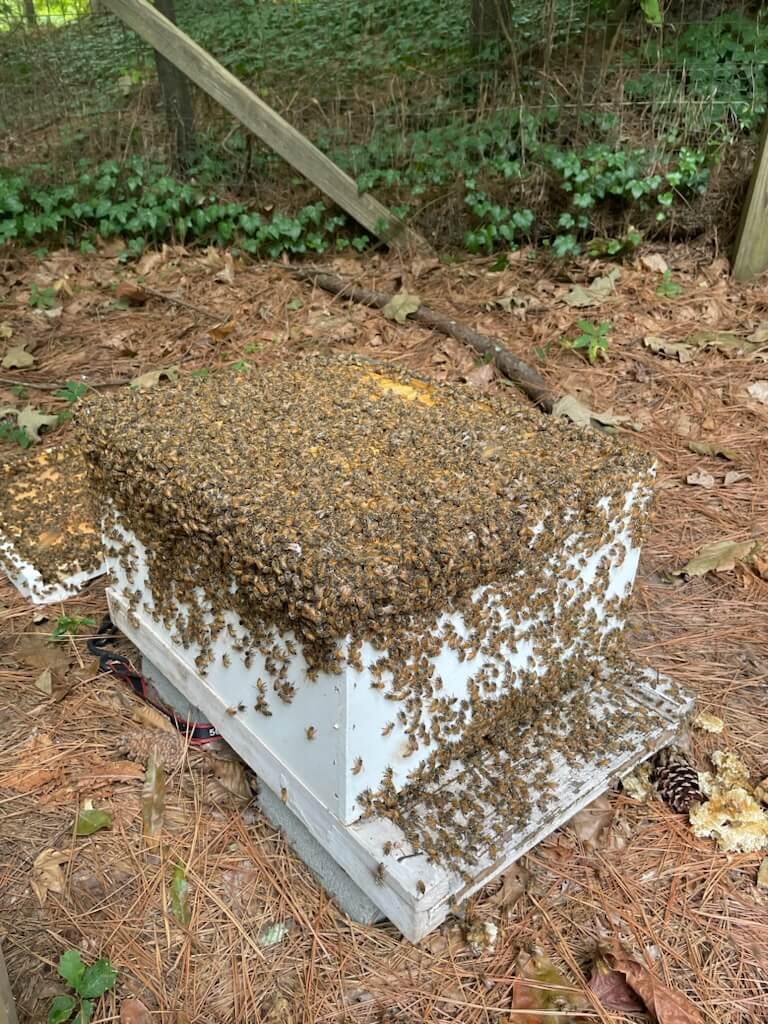All about honey bee swarms (and what to do if you see one)
People often use the word “swarm” to refer to a group of bees or wasps.
For example, you might have seen several yellow jackets excitedly drinking from a sugary spill on the ground and remarked that they were “swarming.” But this isn’t an accurate use of the term.
In beekeeping, swarming refers to a very specific behavior.
Let’s dive into the basics of swarming, misconceptions about this remarkable adaptaion, and what to do if you ever encounter a swarm.
What is a swarm?
Simply put, a swarm is a baby honey bee colony. When a colony casts off a swarm, it is reproducing. The old queen leaves with about two-thirds of the workforce to find a new nest location. The other third of the bees stay behind and raise a new queen.
This new “princess” or virgin queen will leave the hive, mate with about a dozen male drone bees, then return to the hive to begin laying eggs.
Typically, the group of bees that left with the old queen will land within 100 feet from the hive (oftentimes on a tree branch) where they will rest while several hundred “scout” bees go off to search for potential new homes. They will look for a location that is just right—not too big, not too small, not too wet, has the right entrance size, is facing the morning sun, and is well protected.
This is a swarm of bees that have landed on a fence. Once scout bees have found a safe nest location, the cluster will fly away.
When a scout bee finds a location that she thinks is a good fit for her family, she will return to the cluster and perform a dance. This dance communicates the distance and direction of the “real estate listing” she wants to move into, so to speak. Other scouts will follow the dance directions and visit the location to see for themselves.
When all of the scouts agree on a location, the cluster will fly away and move in to their new home. This process of finding a new nest can take a couple of hours or up to several days.
This is a large swarm of bees that have landed in a tree! It’s hard to believe this is only a portion of the bees that were in the hive they left.
Why do bees swarm?
A colony’s number one goal in life is to swarm. Why? Because that’s how they spread their genetics. There are two main signals that tell a honey bee colony it is time to swarm:
Lack of queen pheromone - When a colony is crowded, the queen’s pheromone gets diluted. When the workers can’t smell their queen at the level that they want to, they will raise new queen cells. They will also put the queen on a diet and chase her around the hive so that she’ll be ready to fly during the swarm.
Congestion - If a colony is running out of room, the inside of the hive will get too hot for optimal brood rearing. The heat and excess carbon dioxide send a signal that it may be time to split in two aka swarm. Additionally, if the queen has run out of empty cells to lay eggs in, this will also signal that the colony is big enough to cast off a swarm.
What is a swarm cell in a beehive?
A swarm cell in a beehive is a cell that contains a future queen. Before the old queen leaves, she will lay fertilized eggs in special “queen cups.” These eggs will hatch into larvae and be fed a protein-rich diet of royal jelly by the workers. Royal jelly is produced by a gland in the worker bees’ heads. This diet is what separates a worker from a queen.
The peanut-shaped formations at the bottom of this cell are swarm cells. Inside of each one is a developing queen. If multiple queens emerge at once, they’ll fight to the death!
Before a virgin queen emerges from her swarm cell, the old queen leaves the hive with a portion of the bees. Once the first virgin emerges, she will search the hive for other swarm cells and sting them, killing the developing queen inside. If she doesn’t she will have to fight to the death with another virgin queen.
These swarm cells have already hatched! That means the old queen has already left with some of the workforce to start a new colony. Soon the bees will chew up these cells and repurpose the wax.
As beekeepers, we look diligently for swarm cells during our inspections. These cells typically hang from the bottom of the brood frames.
If a queen cell is in the middle of a frame as opposed to the bottom, it is usually a “supercedure cell.” This means the colony isn’t going to swarm, they are simply replacing their queen because she is old or sick.
Are swarms bad and how do beekeepers stop them?
It is important to note that swarming isn’t bad. In fact, it’s often a sign a colony is healthy! After all, without swarms the honey bee population wouldn’t grow.
Swarms are not aggressive either. Because they have no honey or brood to defend, swarms are more often than not extremely docile.
That said, most beekeepers try to control swarms because they prefer not to lose a large portion of their bees. There are three common methods to prevent—or at least slow down—the swarming instinct:
Add additional boxes - By adding boxes on top of your hive, you give the bees extra room to expand. They will build new comb and create more room for their queen to lay. Eventually, however, they still get too big, the queen’s pheromone will get diluted, and they will swarm.
Tear down developing swarm cells - While we don’t recommend this method, it is followed by many beekeepers and it has it’s time and place. If you open your colony every 5 days, shake the bees off of every frame, and tear down every developing swarm cell you see, you will slow down the swarming process. However, this is highly disruptive to the bees and inevitably you will miss a swarm cell hidden in a nook or cranny of the hive.
Make an artificial swarm aka a split - This is the tried-and-true method of preventing a swarm. When you see a developing queen cell, you can remove the queen along with some bees, pollen, honey, and brood and add them to a new box. This is called a split and in essence it is an artificial swarm. By making your bees think they’ve swarmed, you can propagate your hives without them flying off.
This colony is very congested! It will need to be split to prevent a swarm.
What should you do if you see a swarm?
At Buddha Bee Apiary, we install and maintain honey bee hives at businesses, schools, and backyards. If you are one of our clients and you think your bees are swarming, here’s what you should do:
For the quickest reply, text your beekeeper! Their number is in the bottom of their email signature.
Send your name, address, and the estimated height off the ground
If the bees are mid-swarm, keep an eye on them and try to see where they land
If possible, send us a photo
If there are any curious neighbors or other onlookers, remind them to keep a safe distance. Use the information you learned in this article to help others understand that this is a natural process that isn’t dangerous. We’ll be there soon to catch the swarm and relocate it to our farm!
I want to learn more about swarms!
Swarms are magical. To witness the collective intelligence of bees is an unforgettable experience. If you’d like to read more about swarms, we highly recommend the book Honeybee Democracy by Tom Seeley. The University of Guelph also has an excellent video about swarm prevention. And finally, be sure to follow us on Instagram for all things bees and beekeeping!





